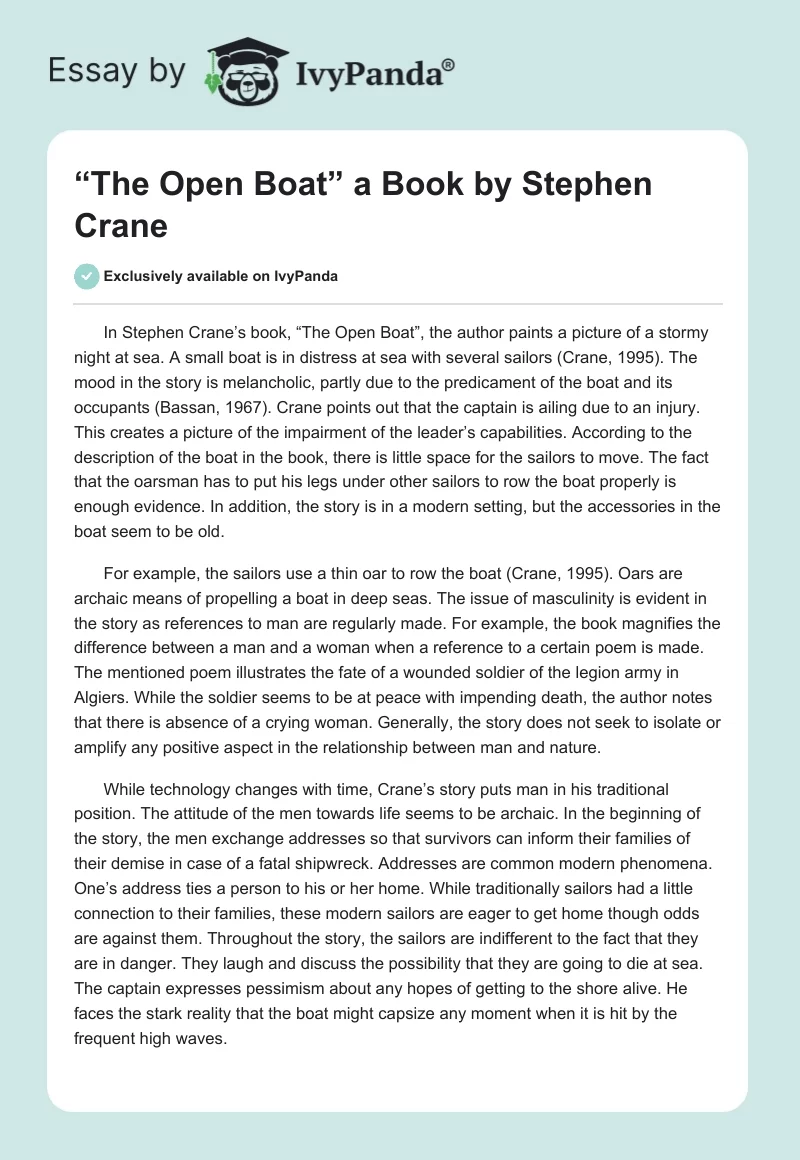In Stephen Crane’s book, “The Open Boat”, the author paints a picture of a stormy night at sea. A small boat is in distress at sea with several sailors (Crane, 1995). The mood in the story is melancholic, partly due to the predicament of the boat and its occupants (Bassan, 1967). Crane points out that the captain is ailing due to an injury. This creates a picture of the impairment of the leader’s capabilities. According to the description of the boat in the book, there is little space for the sailors to move. The fact that the oarsman has to put his legs under other sailors to row the boat properly is enough evidence. In addition, the story is in a modern setting, but the accessories in the boat seem to be old.
For example, the sailors use a thin oar to row the boat (Crane, 1995). Oars are archaic means of propelling a boat in deep seas. The issue of masculinity is evident in the story as references to man are regularly made. For example, the book magnifies the difference between a man and a woman when a reference to a certain poem is made. The mentioned poem illustrates the fate of a wounded soldier of the legion army in Algiers. While the soldier seems to be at peace with impending death, the author notes that there is absence of a crying woman. Generally, the story does not seek to isolate or amplify any positive aspect in the relationship between man and nature.
While technology changes with time, Crane’s story puts man in his traditional position. The attitude of the men towards life seems to be archaic. In the beginning of the story, the men exchange addresses so that survivors can inform their families of their demise in case of a fatal shipwreck. Addresses are common modern phenomena. One’s address ties a person to his or her home. While traditionally sailors had a little connection to their families, these modern sailors are eager to get home though odds are against them. Throughout the story, the sailors are indifferent to the fact that they are in danger. They laugh and discuss the possibility that they are going to die at sea. The captain expresses pessimism about any hopes of getting to the shore alive. He faces the stark reality that the boat might capsize any moment when it is hit by the frequent high waves.
The sailors have an unusual connection with the rest of the world on dry land. This contrasts with the traditional picture of a sailor who is separated from the rest of the world while at sea. For several times, the sailors mention the presence of life saving stations, which are modern installations at many places near the sea. In addition, they make use of a life preserver, a kind of modern technology. They hope to get to a life saving station before their boats gives in to the raging sea. During this journey, the lifesaving stations and the life preservers do not offer any meaningful help to the sailors. At one point, the cook dismisses life saving stations as places where food for shipwrecked sailors is kept. He dispels any hope that there might be a crew capable of saving them on the shore (Cady, 1962).
While the story maintains a traditional sense of seamanship, technology seems to disrupt this thought by merging with the surrounding environment. When the sailors see a man on the shore, they notice that he has a bicycle. Other men on the beach have an object that seems to be a lifeboat on wheels (Crane, 1995). Both parties fail to communicate properly since they cannot understand each other. The captain dismisses the people on land as unhelpful. In addition, he expresses disgust for seagulls, which seem to be in comfortable mood while the sea threatens to drown the sailors.
Later, the sailors identify the wheeled object on dry land as an omnibus belonging to a hotel. They figure out that the modern vehicle is on a rescue mission. The vehicle and the bicycle are usually used for human movement in today’s world. However, the sailors are separated from any rescue using modern technology by the violent sea. Nature is indifferent to the perceived importance of the human being.
This story shows how nature remains in control of man’s fate despite the presence advanced technology. Man’s approach in his endeavors has changed. There are installations of lifesaving stations along the shore, and the sailors carry life preservers. However, the sailors are held captive by nature, and they end up like any crew in a storm in a traditional setting (Bloom, 1987). In this story, man has no power to choose the course of events. Nature decides the ultimate fate of man, while it remains indifferent to his wishes. Despite the presence of modern lifesaving technology for the sailors, their ultimate savior is a lone man who has nothing but his physical strength.
References
Bassan, M. (1967). Stephen Crane; a collection of critical essays.. Englewood Cliffs, N.J.: Prentice-Hall.
Bloom, H. (1987). Stephen Crane. New York: Chelsea House.
Cady, E. H. (1962). Stephen Crane. New York: Twayne Publishers.
Crane, S. (1995). The open boat. Charlottesville, Va.: University of Virginia Library.


